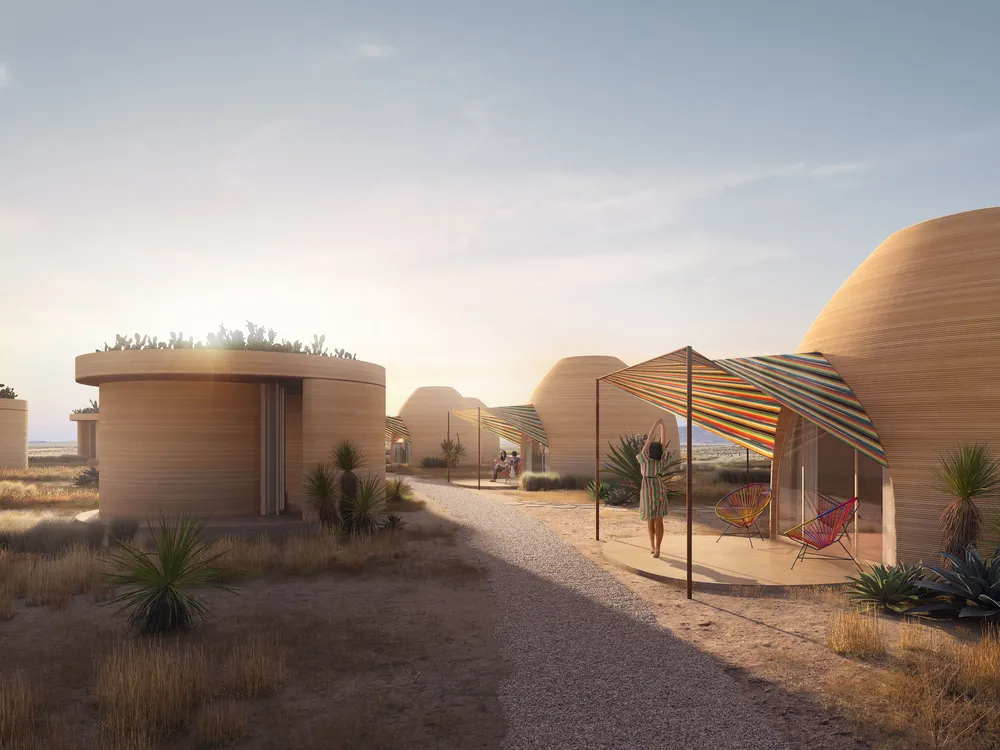The world’s first 3D-printed hotel is being built in the small town of Marfa in the US state of Texas. The ‘El Cosmico’ complex, designed by architecture studio BIG, will also include several residential units. The buildings are scheduled for completion in the year 2026.
The single-story, 12-foot-high walls of the first two units are a three-bedroom residential space and single-room hotel unit.
In collaboration with 3D printing company ICON and architects Bjarke Ingels Group, El Cosmico is constructing the 43-unit hotel and 18 residential homes spread across 60 acres. What makes this project truly extraordinary is its reliance solely on 3D printing technology.
Additionally, this initiative marks a significant milestone in the hospitality industry, as it is the world’s first 3D-printed hotel. El Cosmico’s owner, Liz Lambert, and her partners envision a future where 3D printing can revolutionize the construction process, offering unparalleled creativity and flexibility.
As the hotel is built, it’s workers both adjust and blend the concrete ingredients based on the prevailing weather cconditions Weather aspects such as humidity, temperature, and irradiance affect the material’s behavior and the even final color.
Advantages of 3D Printing on the Project
Lambert emphasizes the limitations of traditional construction methods, where hotels often consist of identical units within four walls. 3D printing, on the other hand,”It allows for intricate architectural features, such as curves, domes, and parabolas, that would be prohibitively expensive to replicate using conventional techniques.” “These unique elements not only enhance the aesthetic appeal but also contribute to a more immersive guest experience.”
The initial units under construction, a three-bedroom residential space and a single-room hotel unit, showcase the potential of 3D printing. Their 12-foot-high walls are being printed by ICON’s Vulcan, a massive 3D printer that extrudes a special cement-based material called Lavacrete. This proprietary mixture is carefully formulated to ensure strength, affordability, and printability, while also being adaptable to varying weather conditions.
Challenges facing 3D Construction
ICON is also actively involved in a 3D-printed neighborhood project near Austin, further demonstrating the potential of this technology to transform the construction industry. However, the integration of 3D printing into the building process raises concerns about its impact on skilled labor jobs. Milad Bazli, a science and technology lecturer, highlights the social and economic implications, particularly in remote areas, that must be carefully considered.
Moreover, as El Cosmico’s expansion project nears completion in 2026, it is poised to redefine the hospitality landscape. The hotel units, priced between $200 and $450 per night, offer travelers a unique and innovative accommodation experience. The success of this venture could pave the way for widespread adoption of 3D printing in the construction of hotels and other buildings, ushering in a new era of architectural possibilities.
Similar Projects: Wolf Ranch
The suburb is a 3D housing development, about 48 kilometres from the state capital.
The development started in late 2022, and about one-third of the homes have already been sold, with prices ranging from $US400,000 to $US600,000.
In any state, the addition of 100 extra homes to the tight housing market would be welcomed — but it’s the way Texan authorities did it that has set this particular development apart.
Senior project manager Conner Jenkins worked on the project.
“Where there were maybe five different crews coming in to build a wall system, we now have one crew and one robot,” he said.
The homes in Wolf Ranch were built using a four-tonne printer.
Also read: Work begins on world’s tallest 3D printed structure, Switzerland
World’s First 3D-Printed Mosque Opens in Saudi Arabia
Construction on Europe’s largest 3D-printed building completed

